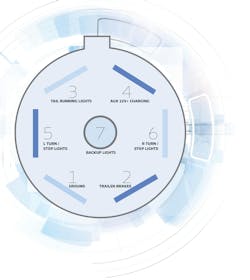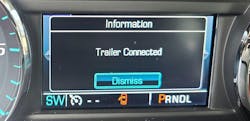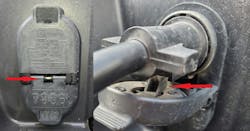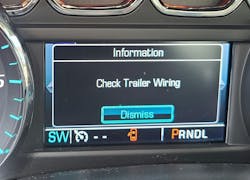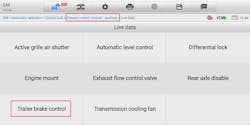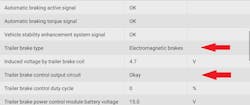Chevrolet and GMC light-duty pickup trucks are at the forefront of towing innovation, featuring an advanced Trailer Towing System that elevates the towing experience. Commencing with the 2014 models, GM took a significant leap forward by integrating a sophisticated trailer brake control system into their light-duty pickup trucks, including the Colorado and Canyon. This innovative system not only enhances control during towing but also introduces the capability to automatically detect the specific type of trailer brakes in use, setting a new standard for precision and convenience in the world of towing technology.
GM’s trailer towing systems can incorporate various sensors, multiple cameras and control modules to check and manage the trailer's behavior, to ensure a smooth and secure towing experience for drivers. However, like any complex system, it is not immune to occasional issues.
In this article, we will explore the diagnostics, technical service bulletins (TSBs), known issues and the functioning of the GM trailer brake system.
The correct power output applied to the trailer brakes is decided by the combination of the braking force exerted by the driver into the vehicle's brake system (via the brake pedal) and the type of trailer brakes that are used on the trailer being towed. The GM trailer brake control system manages the voltage supplied to the trailer brakes through the seven-way connector.
The factory equipped trailer towing system of the 2014 and newer GM pickup trucks includes features such as integrated trailer brake control, trailer sway control and a comprehensive set of vehicle sensors to check trailer conditions. The system uses information from these sensors to adjust braking force, stability control and other parameters, providing a more controlled towing experience.
Two distinct kinds of trailer brake systems are compatible with the GM trailer brake control system offered on 2014 and later GM light duty pickup truck models. Several modules on the vehicle (depending on model year and equipped options) are used to decide the type of trailer brakes being used. To apply the proper trailer brake output, the Chassis Control Module (CCM), Chassis Control Module Auxiliary (CCMA), or Brake System Control Module (BSCM) will figure out the type of trailer brakes.
GM Trailer Brake Components
GM’s trailer brake control system consists of the following components: Trailer Brake Control Switch (TBCS), Brake System Control Module (BSCM) and the Trailer Brake Power Control Module (TBPM).
The trailer brake system uses two separate communication networks to activate the trailer brakes. A dedicated LIN bus is used for communications between the TBPM and the CCM/CCMA (it will depend on year/make/model/equipment level). This LIN bus also shares information with the instrument cluster, for displaying warnings and operational messages from the BSCM, TBCS and the TBPM. The High Speed GMLAN network attached to the BSCM provides access to other vital vehicle information shared on that network enabling the BSCM to make decisions for proper trailer brake operation based on vehicle driving conditions.
The TBCS mounted on the dash, allows the driver to adjust the amount of trailer brake output (trailer gain) sent to the trailer brakes. It also allows for the manual application of the trailer brakes by the driver.
The BSCM is the truck’s brake system controller. It’s attached to the master cylinder and it controls the trailer brake operation, ABS braking, tractional control, Electronic Stability Control (ESC), trailer sway control, hill hold (if equipped) and many other brake/stability related system functions on the truck. The BSCM sends out duty cycled signal commands via the dedicated LIN bus to the TBPM for trailer brake application. The GM Trailer Sway Control uses the ESC system to identify instances of trailer instability and use differential braking to mitigate trailer oscillation and instability. To reduce or cut the back-and-forth motions of the trailer, GM’s Trailer Sway Control can detect the unique vehicle dynamics associated with sway and, if needed, apply the brakes, and reduce engine torque.
The BSCM can activate the trailer brakes to slow down and stabilize the vehicle when a sway condition is encountered. The Trailer Sway Control system can detect and identify instances of recurring instability in the trailer, and then send a warning signal to the instrument display to alert the driver about the unsafe configuration of the trailer.
The TBPM is mounted above the spare tire of the truck. It receives the BSCM’s commands and then provides the trailer brake output voltage, triggering the trailer brake operation. But that is not the TBPM’s only task. It also helps to identify the type of trailer brakes being used and provides diagnostic information on the trailer brake circuit. The TBPM continuously sends test voltage pulses out through the trailer brake output circuit looking for a trailer. When a trailer is attached and plugged in, it will continue to send out these test pulses to identify the type of trailer brakes, and as a diagnostic feature of the trailer brake circuit and its connections.
When a trailer is initially plugged into the truck’s trailer plug, the test pulses sent from the TBPM on the trailer brake output circuit will be altered by the type of trailer brake system and its components and circuitry. The TBPM will report to the CCM and BSCM the way that the test pulse reacted/changed when the trailer plug was attached to the truck and the trailer brake output circuit. The CCM/BSCM will use that information to decide the type of trailer brakes being used.
Note on some wiring diagrams the TBPM may be shown as the CCM or the CCMA — it depends on the year/model and equipment level of the truck.
Electric Trailer Brakes
This system uses the familiar electromagnet/lever arm assembly that is activated by a controlled electrical output signal from the truck, which in turn directly activates the brake mechanism. The light duty GM system can accommodate up to eight trailer brake electromagnets on a four-axle trailer. This trailer brake system will be displayed as "Electromagnetic Brakes" when using the scan tool.
Electric Over Hydraulic (EOH) Trailer Brakes
This trailer brake system utilizes the trailer’s dedicated electric hydraulic brake system and controls the EOH system by an electrical output signal from the towing vehicle. The EOH braking system uses hydraulic pressure to activate the trailer brakes, but instead of the familiar surge brake hydraulic actuator on the trailer tongue, there is now an electrohydraulic actuator supplying the needed brake pressure to activate the trailer brakes. This system cuts the braking lag time that surge brakes encounter and provides much higher hydraulic braking pressure: 1000-1500 psi vs. 400-800 psi that the surge brake actuator could provide. This system allows for the use of trailers with disc brakes. The brake system will be displayed as "Electrohydraulic Brakes" when using the scan tool.
EOH brakes have some unique operating conditions. Most EOH systems require a 20-30% duty cycle to activate the pump motor, and if the trailer gain is set too low, and the brake pedal pressure is light, the pump motor may not function. This is normal. The operator should follow the owner’s manual to ensure that the proper gain setting is set. If the truck has detected EOH and the vehicle is fully stopped, there will be no trailer brake output. This is also normal. Certain EOH systems require a special adapter module to be installed on the trailer for the truck to recognize the trailer and provide the proper trailer brake function. Certain EOH manufacturers have made these adapters available.
Note: If a trailer brake system that is not compatible is connected, the ability to brake the trailer may be partially or entirely disabled. An increased stopping distance or trailer instability may result in personal injury or damage to the vehicle, trailer or other property. An aftermarket controller is necessary for trailers equipped with air or surge trailer brake systems.
Once theCCM/CCMA or BSCM has determined the type of trailer that is plugged in, the TCBM continues to send test pulses, checking the trailer brake circuitry. If an issue is detected on the trailer brake circuit, the driver will be notified with the proper warning message on the instrument cluster and a DTC may be recorded to aid in diagnostics. There can be three distinct warning messages displayed on the instrument cluster:
- "Check Trailer Wiring" comes up as a warning on the dash, even when there isn't a DTC. If the trailer brake output circuit detects an open or high resistance during the current ignition cycle, this message will be shown.
- This is normal when unhooking the trailer or removing the plug from the trailer's wiring while the ignition is turned on.
- This is also a common concern that will intermittently appear on the instrument cluster while towing, then the message goes away. This typically indicates a poor/loose connection on the seven-way trailer plug, (more on this later).
- “Check Trailer Wiring” comes up as a warning on the dash supplemented with the C1114 DTC, but not the “Service Trailer Brake Message.” The problem is likely to be due to a short to ground in the trailer brake output circuit. A “Service Trailer Brake System” message will be accompanied with the C1114 DTC. A poor trailer ground circuit or a short to power on the trailer's brake output circuit could be to blame for this problem.
Evaluating the Trailer Brake System
Trailer brake issues usually stem from wiring or brake issues on the trailer and often have nothing to do with the truck's electrical system. Wiring, connectors, splices and routing in most trailers aren't comparable with the quality and protection that you will find on the factory installed wiring harnesses and connections of today’s vehicles.
Many times, push/block/snap connectors, pouch connectors and wire taps are used during the trailer manufacturing process. As a result, the CCM/BSCM may detect issues and defects that are difficult to identify as being specific to either the truck or the trailer.
GM does build a seven-way trailer brake module tester and trailer simulator (EL-52641) that will attach to the truck's trailer connector. It will simulate the electromagnetic trailer brakes, display that on the scan tool and allow for the checking of the other circuits at the seven-way trailer plug. But this tool does not simulate the load that the electromagnet of the trailer would produce.
GM recommends that techs build a tester with known good functional trailer brake magnets as the quickest and most straightforward method of testing issues in the brake output circuit on trailers with electromagnetic trailer brakes. This tester will apply the correct loads to the truck's electrical system, similar to what a trailer does without requiring the entire trailer. This test rig also makes use of real trailer braking magnets.
When building the brake circuit tester, construct a tester in which the number of trailer brakes can be adjusted by adding or removing pairs of magnets to match the quantity on the customer's trailer.
The test harness can be built using up to eight trailer brake magnets (four axles and the maximum number of trailer brake magnets the system is designed to accept).
Connecting the test harness to the truck's seven-way connector should cause the instrument cluster to indicate "Trailer Connected" and the scan tool to show "Electro-magnetic brakes” in the CCM/BSCM data parameter "Trailer Brake Type." Also, it is recommended to install the trailer brake magnet harness in the truck bed and ensure that the harness is sufficiently long to fit into the vehicle's seven-way connector. This will enable the driver to use the truck as though the trailer was hitched.
If when driving the truck with this test harness installed and you don’t see any dash warning messages or DTCs, the truck is not likely the issue, and you will need to look closely at the trailer wiring, the trailer brakes themselves and the seven-way connector and cable.
Common Issues
Weak or poor connections at the seven-way trailer plug connector are the most typical problems with this system. This issue commonly causes the “Check Trailer Wiring” message to flash on the dash while driving. Certain 2014-2018 trucks have suffered from an issue involving a weak spring-loaded door of the seven-way connector. This door spring not only holds out moisture and debris when the seven-way connector isn’t being used, but it helps hold the trailer plug firmly in the connection. GM has an updated truck-side trailer connector available (PN. 23404450). There have been other updates to the truck side seven-way connector, socket and receptacle on various years or GM trucks, so be sure to check for part updates.
Issues can arise from excessive length trailer harnesses, looping or wrapping the harness under sway bars or sway bar connections causing the connections to be pulled or stressed. Corrosion, improper seven-way plug trailer repairs and poorly made replacement seven-way connector parts (both truck and trailer side) can result in the trailer brakes not functioning and warning messages on the dash. The location of the TBPM above the spare tire exposes the module and its connectors to corrosion and moisture intrusion. There have also been concerns about the TBCS failing, which results in inoperative trailer brakes and sets a C1117 DTC. Evaluating the switch starts by looking at 5-volt reference and ground and then watching the switch control parameters on the scan tool.
Some trailers are factory equipped with electronic sway control, while others may have had this system added later. These systems will apply the trailer’s brakes independently of the towing vehicle to control trailer sway. Be aware that these devices can affect the truck’s ability to decide what type of trailer brake system is on the trailer and can cause dash warning messages and DTCs. There have also been concerns about aftermarket modules installed on trailers with EOH brake systems. These modules will allow a truck that only has electric trailer brake ability to tow an EOH trailer, but they can affect the way the GM system detects the type of trailer that is being attached to the truck.
The innovative trailer brake system used on the Chevrolet and GMC line of light-duty pickup trucks ensures a safe and controlled towing experience for drivers. The integrated features of the system not only adjust trailer braking force and stability control but also utilize advanced technologies such as ESC and Trailer Sway Control to mitigate trailer oscillation and instability.
However, like any complex technology, the GM trailer brake system is not immune to occasional issues. Loose connections, corrosion and other factors can impact its performance. Regular maintenance and adherence to proper procedures are essential to ensure the system operates at its best.
About the Author

Jeff Taylor
Jeff Taylor is a seasoned professional at CARS Inc. in Oshawa with 40 years in the automotive industry. As a skilled technical writer and training developer, he holds licenses in both automotive and heavy-duty vehicle repair. Jeff excels in TAC support, technical training, troubleshooting, and shaping the future of automotive expertise.
